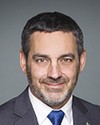Thank you, Mr. Chair and members of the committee.
First let me thank the committee for inviting us here today to discuss issues of national protocol.
As Mr. Moore mentioned, my name is Nicole Bourget and I am the Assistant Deputy Minister of Sport, Major Events and Regions at the Department of Canadian Heritage. I am joined by Denis Racine, Executive Director, Major Events and Celebrations and Joel Girouard, Director, State Ceremonial and Protocol.
Although the issue of protocol is not generally given a lot of outside attention, it is foundational to all of the national ceremonies in Canada and defines the etiquette for the treatment of national symbols such as the national flag of Canada.
Today we would like to take this opportunity to provide the committee with an overview of the types of protocol issues we are responsible for. We will then be happy to answer any questions you may have.
The responsibility for national protocol falls under the mandate of the Department of Canadian Heritage under the Department of Canadian Heritage Act. Protocol, by definition, has to be flexible and adapt to the various players on the political or social stage. Developed through years of experience, officials at the Department of Canadian Heritage have significant experience in the area of national protocol. This experience is put into practice in the delivery of numerous events such as royal tours, state funerals, installations of governors general.
The department also acts as a centre of expertise on issues of domestic protocol and procedures. This includes the rules surrounding the national flag of Canada, its half-masting, display and use. We respond to inquiries from the public on national symbols, the use of royal images, the prefix “royal” and the use of symbols for commercial purposes. This role also involves on-going communication and liaison with provincial and territorial government protocol offices.
I would like to take some time to provide more details on protocol in national events, specifically royal tours and state funerals.
Her Majesty The Queen has toured Canada 22 times. Her Majesty's most recent visit to Canada was in 2010, and in 2011 Canada received Their Royal Highnesses, the Duke and Duchess of Cambridge. This month, as you know, Canada will host the Prince of Wales and the Duchess of Cornwall as part of the Queen's Diamond Jubilee celebrations.
It is important to note the distinction between official and private visits. An official visit is at the invitation of the Governor General. A private visit is one where a member of the royal family undertakes engagements with or on behalf of private organizations. The Department of Canadian Heritage is only involved in official visits.
Royal tours are truly a team effort. The department is not only responsible for planning the tour and ensuring coordination between various partners. We also work with several other federal departments, the Office of the Secretary to the Governor General, representatives from the provinces and territories as well as the royal household, and the Canadian Secretary to the Queen.
Next I'd like to highlight the role the department plays in managing state funerals. A state funeral may be held to honour and commemorate present and former governors general, present and former prime ministers, sitting members of the ministry, and other eminent Canadians at the discretion of the Prime Minister. These national ceremonies provide the occasion for the public to participate in a demonstration of national homage and mourning.
Each state funeral is different, depending on the predetermined wishes of the deceased and the wishes of the family. They do, however, contain some common elements. The department is responsible for the overall coordination of all aspects of the event including the lying in state; the funeral procession; the funeral service; the committal, which may include components of military honours; and the post-committal reception.
The Department of Canadian Heritage is the lead federal department. However, many other government departments as well as provincial, territorial, and municipal governments are involved in the organization and delivery of a state funeral, depending on the complexity and size of the funeral.
While the Office of the Secretary to the Governor General manages issues of protocol for the sitting Governor General, once a new Governor General is identified, it is the responsibility of the Department of Canadian Heritage to provide support for the Governor General Designate until she or he officially assumes office.
The installation ceremony is a major protocol event. It sets the tone for the new Governor General's term and serves as a reflection of the important issues that the Governor General Designate wishes to highlight. As with other significant political events, the department works with numerous partners.
Finally, as I mentioned earlier, the department acts as a centre of expertise on numerous aspects of issues including the proper use of the national flag of Canada.
In this respect, the most visible contribution of the department is in terms of the administration of the Rules for Half-masting the National Flag of Canada. Half-masting being a well-established procedure to bestow an honour and express a collective sense of sorrow.
I thank you all for your time and we'd be pleased to answer any questions you may have.




